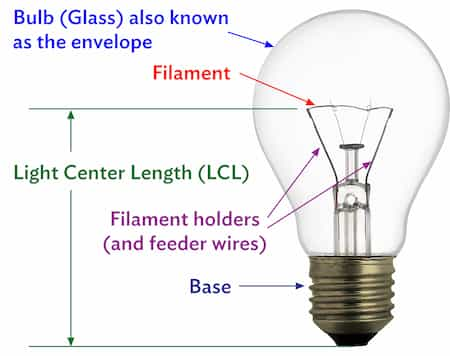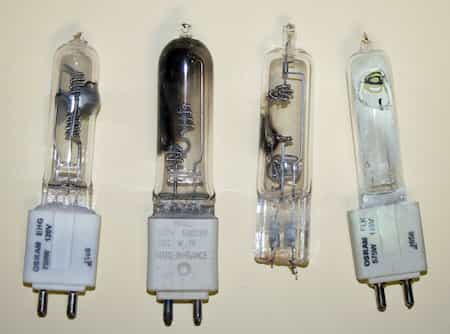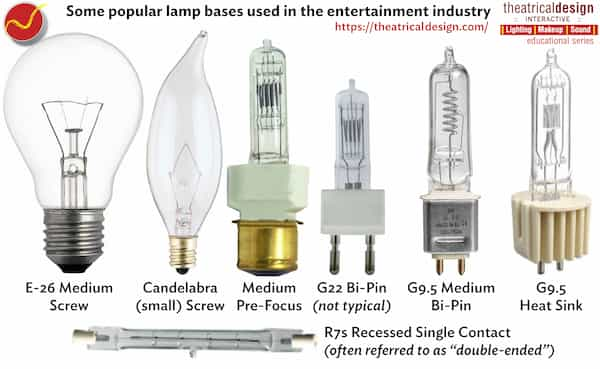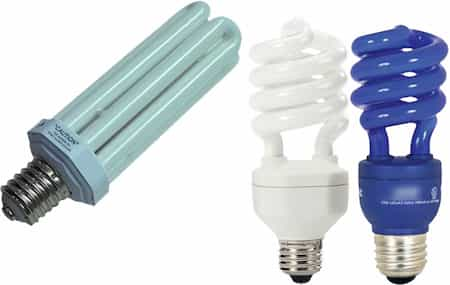Electricity and Power page 6 of 6
Lamps

Industry professionals tend to call these "lamps" because "bulb" technically just refers to the glass.
Although lamps are available in many different configurations, they mostly share the same elements (previous graphic).
The relationship between all of the components of a lamp is very important for lighting instruments to work efficiently. 
The filament is the part that incandesces (glows) when electricity flows through it. Originally made of carbon, nearly all filaments are now made of tungsten.
In household lamps, the gas inside the bulb is either a vacuum or filled with an inert gas. Active gases, such as oxygen, could interact with the heat being produced and explode. Inert gases, like argon, don't react to the heat.
Remember that lighting fixtures are projectors; they generally focus light and send it in a specific direction with certain characteristics (described more in-depth in the "Equipment" segment). For top efficiency, filaments need to be small and bright.
As the filament heats up, little particles of the tungsten become detached, and because heat rises; they rise…collecting on the top of the bulb and eventually creating a dark spot within the lamp which also dims the light output of the lamp.
As the filament heats up, little particles of the tungsten become detached, and because heat rises; they rise…collecting on the top of the bulb and eventually creating a dark spot within the lamp which also dims the light output of the lamp.
In most theatre lamps, the inert gas has been replaced with halogen gas. This causes a halogen cycle chemical reaction which redeposits the burned-off pieces of filament back onto the filament. This prolongs the life and intensity of the lamp. Generally referred to as "tungsten - halogen" lamps (tungsten being what the filament is made of; halogen being the active glass in the bulb).
The smaller size and brighter burning of the bulb also make for more efficient lamps which in turn serve as more efficient lighting instruments.
The halogen cycle requires heat to be activated; so tungsten halogen lamps tend to be small (and concentrated) with quartz glass bulbs which can stand up to the heat being created by the burning filament.
The smaller size and brighter burning of the bulb also make for more efficient lamps which in turn serve as more efficient lighting instruments.
The halogen cycle requires heat to be activated; so tungsten halogen lamps tend to be small (and concentrated) with quartz glass bulbs which can stand up to the heat being created by the burning filament.
The glass bulb portion of lamps range in shapes and sizes sometimes specifically for a certain look or fitting – or sometimes their shape is quite random.Household light bulbs are typically "type A" and the A stands for "arbitrary". Their sizes are of generally similar shape and size but are not specific.
Glass Bulb Shapes

Graphic and information from LampTech.
More information about the shapes of glass bulbs.
Because theatre lamps burn so hot; any fingerprints (essentially grease) left on the bulb will make the heat burn unevenly – drastically shortening the life of the lamp, typically causing the bulb to break.
It's important to avoid touching the glass of a lamp when installing a new one. Employing gloves, tissues or handkerchiefs can help you prevent this problem.
Different lighting fixtures use different lamps; but each one has very specific requirements for size, shape, and type of light. Because there are different manufacturers of lamps that each need to fit specific fixtures; lamps can have codes set by the American National Standards Institute (ANSI).
Would you be able to tell the difference between these lamps if they weren't next to each other?
Most theatre-style lamps have the ANSI code printed directly on their base. Generally, there are too many ANSI codes for you to remember what they all mean; but if you use a similar inventory constantly, you'll quickly get to know the commonly used lamps in your theatre.
Bases are available in an array of styles as well as sizes. While 'medium screw bases' are typical for the home; because theatrical instruments require specific alignment and placement of the filament; most industry lamps use either pre-focus bases (that twist and lock into place) or a type of bi-pin base.
A quick word about Compact Fluorescent Lamps (and fluorescents in general). Fluorescent lamps are far more energy-efficient, but their light is very unfocused. They also use a small amount of mercury in their manufacturing, typically are slow to "warm up", and don't dim gracefully.
Generally fluorescents are only used backstage, and occasionally for work lights.
Generally fluorescents are only used backstage, and occasionally for work lights.
LEDs (light emitting diodes) are beginning to work their way into the entertainment industry. Typically, however, they are used in lighting fixtures that have been specifically designed for this technology --- so LED fixtures are covered in the instrumentation segment of this website.







